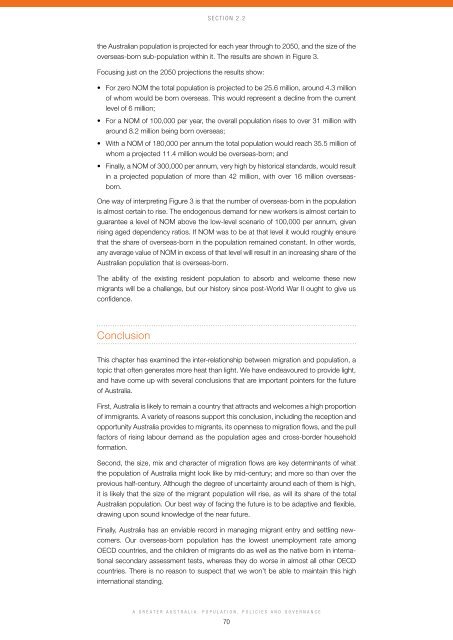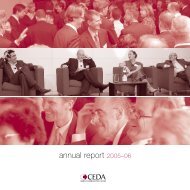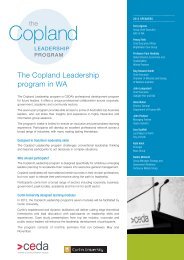A Greater Australia: Population, policies and governance - CEDA
A Greater Australia: Population, policies and governance - CEDA
A Greater Australia: Population, policies and governance - CEDA
- No tags were found...
You also want an ePaper? Increase the reach of your titles
YUMPU automatically turns print PDFs into web optimized ePapers that Google loves.
Section 2.2the <strong>Australia</strong>n population is projected for each year through to 2050, <strong>and</strong> the size of theoverseas-born sub-population within it. The results are shown in Figure 3.Focusing just on the 2050 projections the results show:• For zero NOM the total population is projected to be 25.6 million, around 4.3 millionof whom would be born overseas. This would represent a decline from the currentlevel of 6 million;• For a NOM of 100,000 per year, the overall population rises to over 31 million witharound 8.2 million being born overseas;• With a NOM of 180,000 per annum the total population would reach 35.5 million ofwhom a projected 11.4 million would be overseas-born; <strong>and</strong>• Finally, a NOM of 300,000 per annum, very high by historical st<strong>and</strong>ards, would resultin a projected population of more than 42 million, with over 16 million overseasborn.One way of interpreting Figure 3 is that the number of overseas-born in the populationis almost certain to rise. The endogenous dem<strong>and</strong> for new workers is almost certain toguarantee a level of NOM above the low-level scenario of 100,000 per annum, givenrising aged dependency ratios. If NOM was to be at that level it would roughly ensurethat the share of overseas-born in the population remained constant. In other words,any average value of NOM in excess of that level will result in an increasing share of the<strong>Australia</strong>n population that is overseas-born.The ability of the existing resident population to absorb <strong>and</strong> welcome these newmigrants will be a challenge, but our history since post-World War II ought to give usconfidence.ConclusionThis chapter has examined the inter-relationship between migration <strong>and</strong> population, atopic that often generates more heat than light. We have endeavoured to provide light,<strong>and</strong> have come up with several conclusions that are important pointers for the futureof <strong>Australia</strong>.First, <strong>Australia</strong> is likely to remain a country that attracts <strong>and</strong> welcomes a high proportionof immigrants. A variety of reasons support this conclusion, including the reception <strong>and</strong>opportunity <strong>Australia</strong> provides to migrants, its openness to migration flows, <strong>and</strong> the pullfactors of rising labour dem<strong>and</strong> as the population ages <strong>and</strong> cross-border householdformation.Second, the size, mix <strong>and</strong> character of migration flows are key determinants of whatthe population of <strong>Australia</strong> might look like by mid-century; <strong>and</strong> more so than over theprevious half-century. Although the degree of uncertainty around each of them is high,it is likely that the size of the migrant population will rise, as will its share of the total<strong>Australia</strong>n population. Our best way of facing the future is to be adaptive <strong>and</strong> flexible,drawing upon sound knowledge of the near future.Finally, <strong>Australia</strong> has an enviable record in managing migrant entry <strong>and</strong> settling newcomers.Our overseas-born population has the lowest unemployment rate amongOECD countries, <strong>and</strong> the children of migrants do as well as the native born in internationalsecondary assessment tests, whereas they do worse in almost all other OECDcountries. There is no reason to suspect that we won’t be able to maintain this highinternational st<strong>and</strong>ing.A <strong>Greater</strong> <strong>Australia</strong>: <strong>Population</strong>, Policies <strong>and</strong> Governance70





